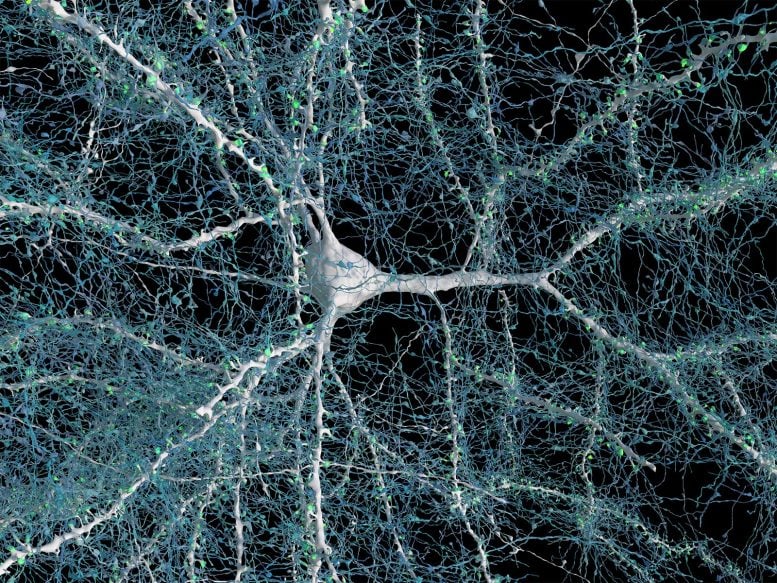
Researchers used high-resolution electron microscopy to image a small piece of human brain tissue, generating a 3D map of over 57,000 cells and nearly 150 million synapses. Their findings reveal intricate details about cell types and connections, highlighting the complexity of the brain and advancing the field of connectomics.
- Researchers generated a high-resolution map of all the cells and connections in a single cubic millimeter of the human brain.
- The results reveal previously unseen details of brain structure and provide a resource for further studies.
Fully understanding how the human brain works requires knowing the relationships between the various cells that make up the brain. This entails visualizing the brain’s structure on the scale of nanometers in order to see the connections between neurons.
Imaging Techniques and Research Methodology
A team of researchers, led by Dr. Jeff Lichtman at Harvard University and Dr. Viren Jain at Google Research, used electron microscopy (EM) to image a cubic millimeter-sized piece of human brain tissue at high resolution. The tissue was removed from the cerebral cortex of a patient as part of a surgery for epilepsy.
The team began by cutting the tissue into more than 5,000 slices, or sections, each of which was then imaged by EM. This yielded about 1.4 petabytes, or 1,400 terabytes, of data. Using these data, the researchers generated a 3D reconstruction of almost every cell in the sample. Results of the NIH-funded study were published in the journal Science.

Detailed Findings and Cellular Analysis
Analysis of individual cells in the sample revealed a total of more than 57,000 cells. Most of these were either neurons, which send electrical signals, or glia, which provide various support functions to the neurons. Glia outnumbered neurons 2-to-1. The most common glial cells were oligodendrocytes, which provide structural support and electrical insulation to neurons. The one cubic mm sample also contained about 230 mm of blood vessels.
The reconstruction revealed structural details not seen before. The researchers analyzed a type of neuron, called triangular cells, that are found in the deepest layer of the cerebral cortex. Many of these adopted one of two orientations, which were mirror images of each other. The significance of this organization remains unknown.
Synapses and Connections
The team used machine learning to identify synapses—the junctions through which signals pass from one cell to another. They found almost 150 million synapses. Almost all neurons formed only one synapse with a given target cell. But a small fraction formed two or more synapses to the same target.
In at least one case, more than 50 synapses connected a single pair of cells. Although rare, connections of seven or more synapses between cells were much more common than expected by chance. This suggests that these strong connections have some functional significance.
Connectomics and the Complexity of the Brain
The results illustrate just how complex the brain is at the cellular level. They also show the value of connectomics—the science of generating comprehensive maps of connections between brain cells—for understanding brain function.
“The word ‘fragment’ is ironic,” Lichtman says. “A terabyte is, for most people, gigantic, yet a fragment of a human brain—just a miniscule, teeny-weeny little bit of human brain—is still thousands of terabytes.”
The team has made their dataset available to the public. They have also provided various software tools to help examine the brain map. The hope is that further study of the data, by this team and others, will yield new insight into the workings of the human brain.
“This incredible advancement—the ability to capture and process over 1,000 terabytes of data from the brain—wouldn’t have been possible without a study participant’s generous donation and the important partnerships between neuroscientists, computer scientists, and engineers,” says Dr. John Ngai, director of NIH’s BRAIN Initiative. “These collaborations are central in our aim of building a full map of the human brain so we can bring cures closer to the clinic.”
For more on this research:
- Harvard and Google Create Intricately Detailed 1,400 Terabyte 3D Brain Map
- Nanoscale 3D Mapping Reveals Revolutionary Insights Into Brain Structure
Reference: “A petavoxel fragment of human cerebral cortex reconstructed at nanoscale resolution” by Alexander Shapson-Coe, Michał Januszewski, Daniel R. Berger, Art Pope, Yuelong Wu, Tim Blakely, Richard L. Schalek, Peter H. Li, Shuohong Wang, Jeremy Maitin-Shepard, Neha Karlupia, Sven Dorkenwald, Evelina Sjostedt, Laramie Leavitt, Dongil Lee, Jakob Troidl, Forrest Collman, Luke Bailey, Angerica Fitzmaurice, Rohin Kar, Benjamin Field, Hank Wu, Julian Wagner-Carena, David Aley, Joanna Lau, Zudi Lin, Donglai Wei, Hanspeter Pfister, Adi Peleg, Viren Jain and Jeff W. Lichtman, 10 May 2024, Science.
DOI: 10.1126/science.adk4858